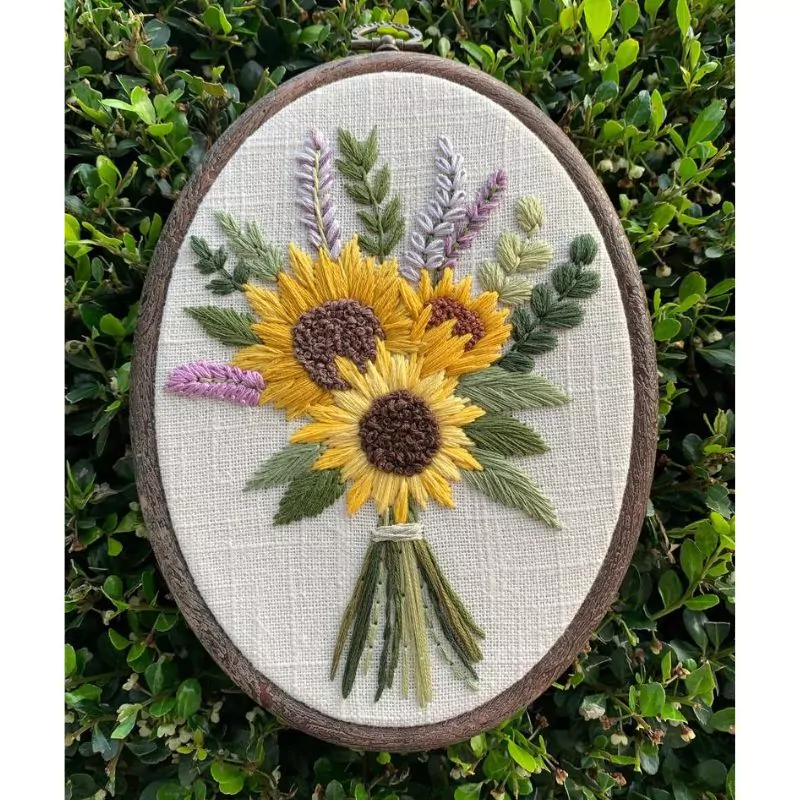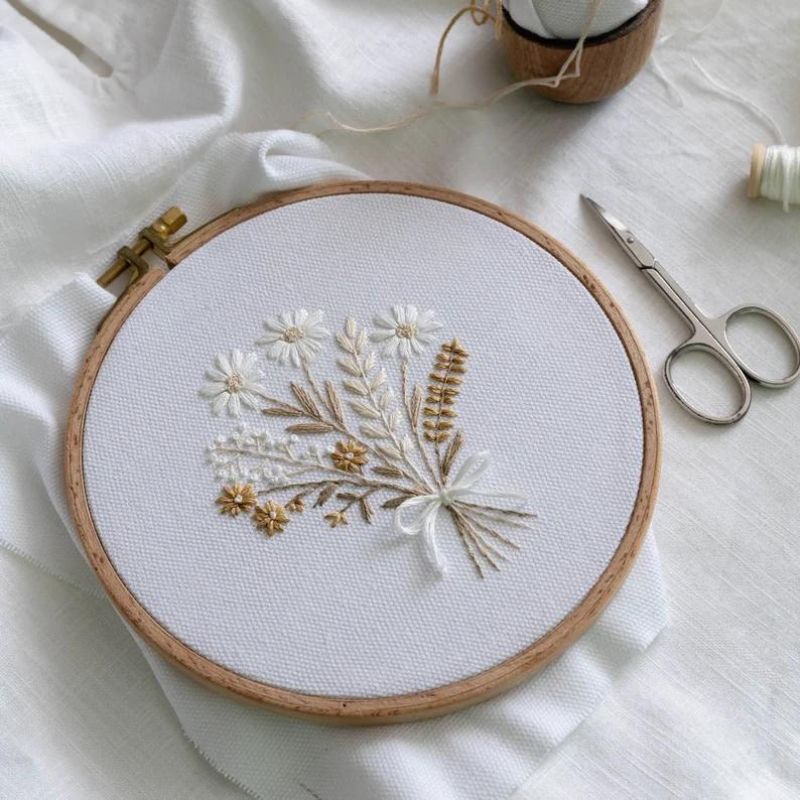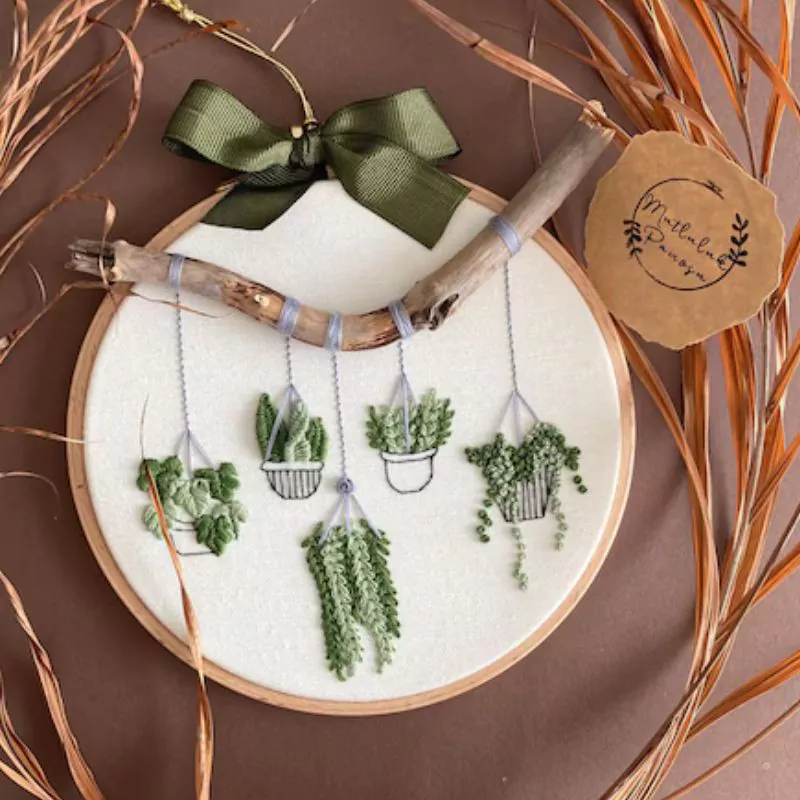Botanical Embroidery Patterns: Nature-Inspired Stitching
Embroidery, a timeless art form, has evolved to encompass many styles and patterns. Botanical embroidery patterns stand out for their intricate designs and the sense of tranquility they evoke. If you’re a fan of nature or simply looking to add a touch of natural beauty to your stitching projects, botanical embroidery offers a delightful avenue to explore. I hand-picked some of the nature-inspired embroidery designs on Etsy that might inspire your creativity and help you start embroidering nature right away.
The Allure of Botanical Embroidery
Botanical embroidery patterns capture the essence of nature in thread and fabric. The idea of botanical embroidery immediately summons images of delicate flowers, lush foliage, and vibrant plant life, all meticulously crafted with needle and thread. This embroidery style celebrates nature’s beauty and allows embroiderers to bring some of the outdoors into their homes or wardrobes, no matter the season.
Why Choose Botanical Embroidery?
Timeless Appeal: Botanical motifs always stay in style. They have been a favorite subject in various art forms for centuries, making them a classic choice for embroidery projects.
Versatility: Botanical patterns can be adapted to suit any project, whether embellishing a piece of clothing, creating a wall hanging, or designing a cushion cover.
Therapeutic Benefits: Embroidery, particularly with nature-inspired designs, can be a relaxing and meditative activity, offering a welcome escape from the hustle and bustle of everyday life.
Popular Botanical Embroidery Patterns
Botanical embroidery encompasses various designs, each with a unique appeal. Here are some popular categories and examples to inspire your next project:
Floral Patterns
Flowers are the most beloved subject in botanical embroidery. From dainty daisies to bold sunflowers, floral patterns can vary significantly in complexity and style.
Roses: Roses are the queen of flowers. These blooms are a favorite in embroidery because of their intricate petals and symbolism of love and beauty. Embroidering roses can be a rewarding challenge, requiring mastering different stitches to capture their layered look.
Wildflowers: A mix of flowers, such as daisies, poppies, and cornflowers, can create a vibrant and whimsical design. Wildflower patterns are excellent for those who enjoy a more free-form and eclectic approach to embroidery.
Floral Bouquets: From romantic bouquets featuring roses, peonies, and baby’s breath to garden bouquets inspired by an English cottage garden. Seasonal bouquets capture the essence of a particular season by combining flowers that bloom during that time. Spring bouquets include tulips, daffodils, and hyacinths, while autumnal arrangements feature chrysanthemums, dahlias, and asters.
Leafy Designs
With their diverse shapes and sizes, leaves offer endless possibilities for botanical embroidery. They can be used as standalone designs or combined with floral elements to create more complex compositions.
Monstera Leaves: Recently, the distinctive, fenestrated leaves of the monstera plant have become a trendy motif. Their bold, graphic shape makes them a striking choice for modern embroidery projects.
Garden herbs: Known for their calming properties, various herbs make a serene and elegant embroidery pattern. These include lavender, rosemary, chamomile, thyme, sage, chive, and dill. These motives are typically used on scented sachets, kitchen towels, or to decorate laundry bags.
Succulent and Cacti Patterns
Succulents and cacti offer a fresh take on botanical embroidery for those who prefer a more contemporary and minimalist look.
Houseplants like Aloe Vera: The spiky, fleshy leaves of aloe vera and similar plants are a fun and unique subject for embroidery. Their geometric shapes can be highlighted with bold lines and vibrant colors.
Cacti: Cacti, with their distinctive silhouettes and occasional flowers, are perfect for creating quirky and eye-catching embroidery designs. They also provide an opportunity to play with texture, using stitches that mimic the prickly surface of these desert plants.
Succulents: Succulents like echeverias, which grow in rosette shapes, offer a beautiful and symmetrical design element. Their overlapping leaves can be embroidered with gradient colors to achieve a realistic effect.
Abstract botanical patterns
Abstract botanical patterns offer an exciting alternative for those who enjoy a more modern and artistic approach to embroidery. These designs focus on the essence and form of plants and flowers rather than realistic depictions, allowing for a more imaginative and expressive interpretation.
Abstract botanical embroidery allows for a high degree of creativity and personal expression. You can create unique and modern pieces that reflect your artistic vision by focusing on plants’ shapes, colors, and textures.
Techniques and Stitches for Botanical Embroidery
Embroidery is a versatile craft, and there are numerous techniques you can use to bring your botanical designs to life. Here are some essential stitches and methods to enhance your botanical embroidery patterns:
- Backstitch: The Backstitch is fundamental in embroidery. It’s ideal for outlining shapes and adding details. It’s simple yet effective, perfect for defining the edges of leaves and petals.
- Satin Stitch: This stitch fills areas with solid color. It’s handy for creating smooth, solid leaves or petals. Achieving a consistent satin stitch can take practice, but the results are worth the effort.
- French Knot: Perfect for adding texture and tiny details, the French knot can create the centers of flowers or tiny buds. It’s a versatile stitch that adds dimension to your work.
- Thread Painting: Also known as needle painting, this technique involves using long and short stitches to create a painterly effect. It’s ideal for rendering intricate details and achieving realistic shading in botanical designs.
Every hand embroidery artist recommends the stitches for their design. If you decide to embroider one of the botanical designs I suggested in this article, follow the instructions and use the recommended stitches.
If you want to design your own botanical embroidery, download my free e-book, “Five Essential Hand Embroidery Stitches for Beginners,” to learn the basic stitches.
Tips for Creating Stunning Botanical Embroidery
To ensure your botanical embroidery projects are as beautiful as they can be, consider these tips:
Choose the Right Fabric
The fabric you choose can significantly impact the final look of your embroidery. Linen and cotton are the dominant options because of their durability and smooth surface, which makes stitching easier and more precise. Choose a fabric with a tight weave to support detailed work.
Select High-Quality Threads
Using high-quality embroidery threads can make a big difference in the appearance and longevity of your finished piece. Look for threads with a smooth texture and vibrant colors that won’t quickly fade or fray. Popular brands like DMC and Anchor offer various colors and thread types like embroidery floss, pearl cotton or wool, to suit any project.
Use an Embroidery Hoop
An embroidery hoop keeps your fabric taut, making stitching more comfortable and accurate. Choose a hoop that fits your project size and adjust it to maintain consistent tension while you work. Consider using a hoop stand for a more comfortable stitching experience.
Choose a proper technique for pattern transfer
Some botanical embroidery patterns are rather complex and detailed, so transferring the design to the fabric can be tricky. Read the article “How To Trace Pattern on Fabric: Five Methods For Fast And Easy Embroidery Pattern Transfer” to choose the best method that suits your situation.
Practice Proper Technique
Take the time to learn and practice different stitches before starting your project. Watching video tutorials and following step-by-step guides can help you master the techniques required to create intricate botanical designs.
Free Botanical designs on this blog
If you are looking for a simple botanical project suitable for a beginner, consider these options:
Over to you
Botanical embroidery patterns offer a delightful way to bring the beauty of nature into your stitching projects. From intricate floral designs to modern succulent motifs, there’s a wealth of inspiration to explore. By mastering various techniques, you can create stunning botanical embroidery pieces that are timeless and unique. Whether you’re a seasoned embroiderer or just starting out, the world of botanical embroidery is rich with possibilities for you to explore and enjoy.


































